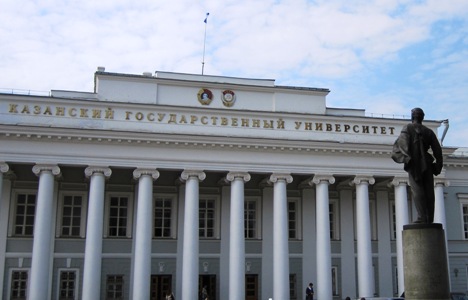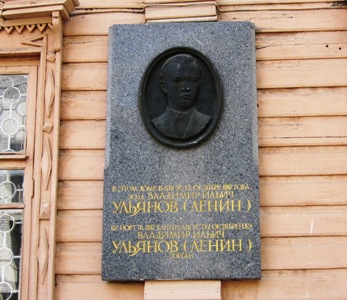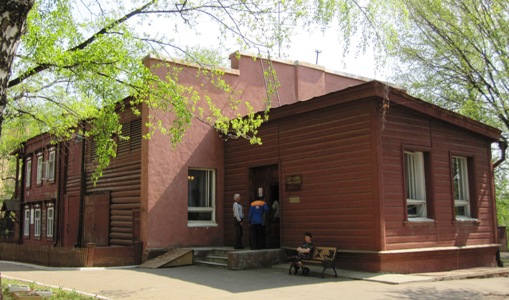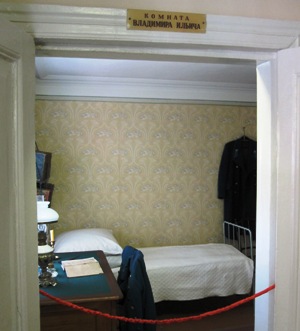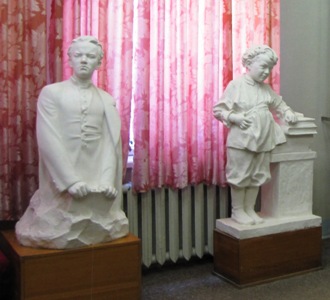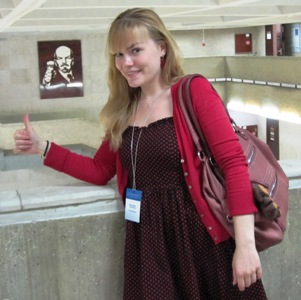Part II: «Казань – ленинская» [Lenin’s Kazan’] Posted by josefina on May 10, 2010 in Culture, History, Russian life, Soviet Union, when in Russia
«Казанский государственный университет» [Kazan’ State University] is since 1925 and still today «имени Владимира Ильича Ульянова–Ленина» [named after Vladimir Il’ich Ul’yanov-Lenin]. And in front of the university’s main building we have a very young «Володя Ульянов» [Volodya Ul’yanov] – aged seventeen and not yet aware of his imminent expulsion from the university…
In August 1887 «Володя Ульянов» [Volodya Ul’yanov], aged seventeen, began his studies «на юридическом факультете» [at the faculty of jurisprudence] of Kazan (then Imperial; soon to be renamed Federal – at the moment State) University. Little did he know at the time that he was not to study there for more than four months – following his involvement in a student uprising at the university in December 1887 he was soon expelled from this institution of higher education. The university is now named after him – the only case in the world where a university has been named in honor of an expelled student? Of course, «Володя Ульянов» [Volodya Ul’yanov] was not expelled «из–за неуспеваемости» [because of poor grades (student’s failure; poor progress in studies)] but «по политическим причинам» [for political reasons], so naming the university in honor of him isn’t completely without ground. At Kazan’ State University’s museum they have preserved «одна аудитория юридического факультета того времени» [one auditorium of the faculty of jurisprudence from that time] and thus you can both feel what it might have been like to be a student (and have a seat at one of the wooden desks and guess if this might have been the same place where Lenin once sat) as well as from the teacher’s point of view (when sitting down behind the professor’s chair). But «это не всё» [this is not all]! Outside of the main hall of the university where the student uprising took place in December 1887 there are two plaques – one «на русском языке» [in Russian language] and one «на татарском языке» [in Tatar language] – saying that this was the place where Lenin was to be found on this fateful day. Our guide explained to us that Lenin’s role in this had been greatly ‘overestimated’ as he was but a first year student and «университетская дедовщина» [university hazing] of those days were «страшная» [terrible], so the future famous revolutionary had been most likely to be found in the very back of the hall. While saying this, our guide pointed to a likely spot and everyone’s eyes turned to this particular spot. «Вот это да!» [literally: ‘That’s this is yes!’; but roughly: That’s great!]
«Памятная доска на доме, в котором Володя Ульянов жил в 1887 (тысяча восемьсот восемьдесят седьмом) году» [Memorial plaque on the house where Volodya Ul’yanov lived in 1887]. Note how the age of Lenin on this plaque corresponds to the actually age at which he lived in this particular building. Now that’s what I call «быть аккуратным» [to be accurate]!
There are plenty of different museums in Kazan’; you name it, they have it! There are also many, many literary museums dedicated to great writers and poets, Russian as well as Tatar – which I should have gone to instead, but for some strange reason the only museum I decided to visit on my own while in town was «Дом–музей В. И. Ленина» [The House-Museum of V. I. Lenin]. I don’t even really know why I was so intent on visiting this particular museum – «у меня было хорошее предчувствие и большое любопытство» [I had a good premonition and a big curiosity]. I’m not a huge fan of Lenin, but this has mainly to do with me being exceedingly ignorant of him – the real person, once known as «Володя Ульянов» [Volodya Ul’yanov] that is – so visiting this museum was an important step toward enlightenment for me: both political and historical. The museum is located «на улице Ульянова–Ленина» [on the Ul’yanov-Lenin Street] in Kazan (number 58; it is open from 11.00 am to 18.00 all days except for Mondays). This tricky street name was meant for such a simple-minded tourist as myself to get it mixed up and thus end up asking people on the street: «Где улица Ленина–Ульянова?» [Where is the Lenin-Ul’yanov street?]. But the inhabitants of Kazan’ are a kind people; one passersby corrected me with a subtle smile as he said: «Нет, девушка, наоборот – сначала он был Ульяновом, только потом стал Ленином. Вот и название улицы это очень точно передаёт» [No, girl (the usual way in Russia of referring to a young woman who’s name you don’t know), it’s the other way around – first he was Ul’yanov, only later did he become Lenin. And the name of the street expresses this very exact]. Soon after this I found the museum and marveled at Russia’s magnificent and available cultural institutions – a student’s ticket to this museum costs only «15 (пятнадцать) рублей» [fifteen rubles] (I think that’s only about 50 US cents?!) – the same as a one-way ticket by bus in Kazan’. Even if you’re not a big admirer of Lenin, you still have to appreciate the fact that you will not have to go into dept to find out a thing or two about his youth in Kazan’…
A view of the «Дом–музей В. И. Ленина» [The House-Museum of V. I. Lenin] from outside. It is located in a small garden, a very calm and nice place in this otherwise bustling and busy big city.
Here you can have a glimpse of «комната Владимира Ильича» [Vladimir Il’ich’s room]. He had a separate entrance and his own stove – did you know?!
I love visiting such ‘house-museums’ in Russia – well, anywhere in the world actually – but most of all in Russia. The «экскурсоводы» [tour guides] are almost always older women who are very kind and talkative and if you seem especially interested in their topic and ask a couple of informed questions on the same topic, then sometimes you don’t have to pay extra for the excursion. That’s what happened to me at this museum; I told one of the women when I paid for my ticket that «я из Швеции» [I’m from Sweden] at which she told me that «коммунисты со всего мира сюда приезжают» [communists from all over the world come here] and that it would be a pleasure for her to show me around. She showed me everything and even invited me to take pictures everywhere (this is very rare at Russian museums – either you have to pay extra to take pictures or the museum workers take a liking to you and allow you to do it for free, sometimes they might even let you go into the ‘restricted’ areas – but this also means that they’ll invite you for tea and/or vodka afterwards). I didn’t tell the nice woman with «татарский акцент» [Tatar accent] that I wasn’t really a Swedish communist, for then she might not have given me such a thorough tour of the place. Interesting enough, all the workers at the museum spoke with each other «по–татарски» [in Tatar] which made me feel as if I was truly in a foreign country… She even pointed out that one of Lenin’s younger sisters spoke Swedish and that the Ul’yanov family had some «шведская кровь» [Swedish blood] among their ancestors. Now this I did not know! «Интересно!» [Interesting!]
A couple of – to me at least – weird statues of Lenin in his childhood (to the right) and in his youth (to the left).
These statues can be found in a special room in the museum recording Lenin’s time in Kazan’ from day one. There’s another room with a big sign on the door proudly proclaiming «Ленин в искусстве» [Lenin in art]. I was surprised to find a lot of poems among its items. All in all, this museum is very much worth a visit when in Kazan’. Sadly, it does not have a gift shop so you can’t buy neither a t-shirt nor a cup with young «Володя Ульянов» [Volodya Ul’yanov] on it. And they don’t have a book for visitors to write their impressions and suggestions in, so I was unable to suggest they add this to their already very fabulous, informative and highly affordable cultural institution.
Lenin can be found almost everywhere – you just have to keep an open eye and an open mind. Not only does he stand on the main square of Kazan’ – «площадь свободы» [Freedom Square] – but here he is inside Kazan State University. I have no idea what he’s holding in his hand, but I don’t seem to care. Thumbs up, «Ильич» [Il’ich (sometimes in Russian culture they call people simply by their patronymic)]!
I can’t say that visiting the museum instantly turned me into a Lenin fanatic, but at least it got me interested in finding out more about the Russian history – and maybe even read some books on the Russian October Revolution… Back when I was younger I was interested in this, but at the time I didn’t speak Russian so I could only read «западные источники» [western resources] which is, after all, only representative of some points of views. It is always good to know the OTHER side of the story, too. If I had a glass of vodka in my hand right now I would make a toast to «толерантность и право на собственное мнение» [tolerance and the right to have an opinion of one’s own] – two of the most important things connected with Kazan’ in my mind according to my personal impressions of this beautiful city. But I don’t, so I’ll have to save that one for later in the evening…

Build vocabulary, practice pronunciation, and more with Transparent Language Online. Available anytime, anywhere, on any device.



